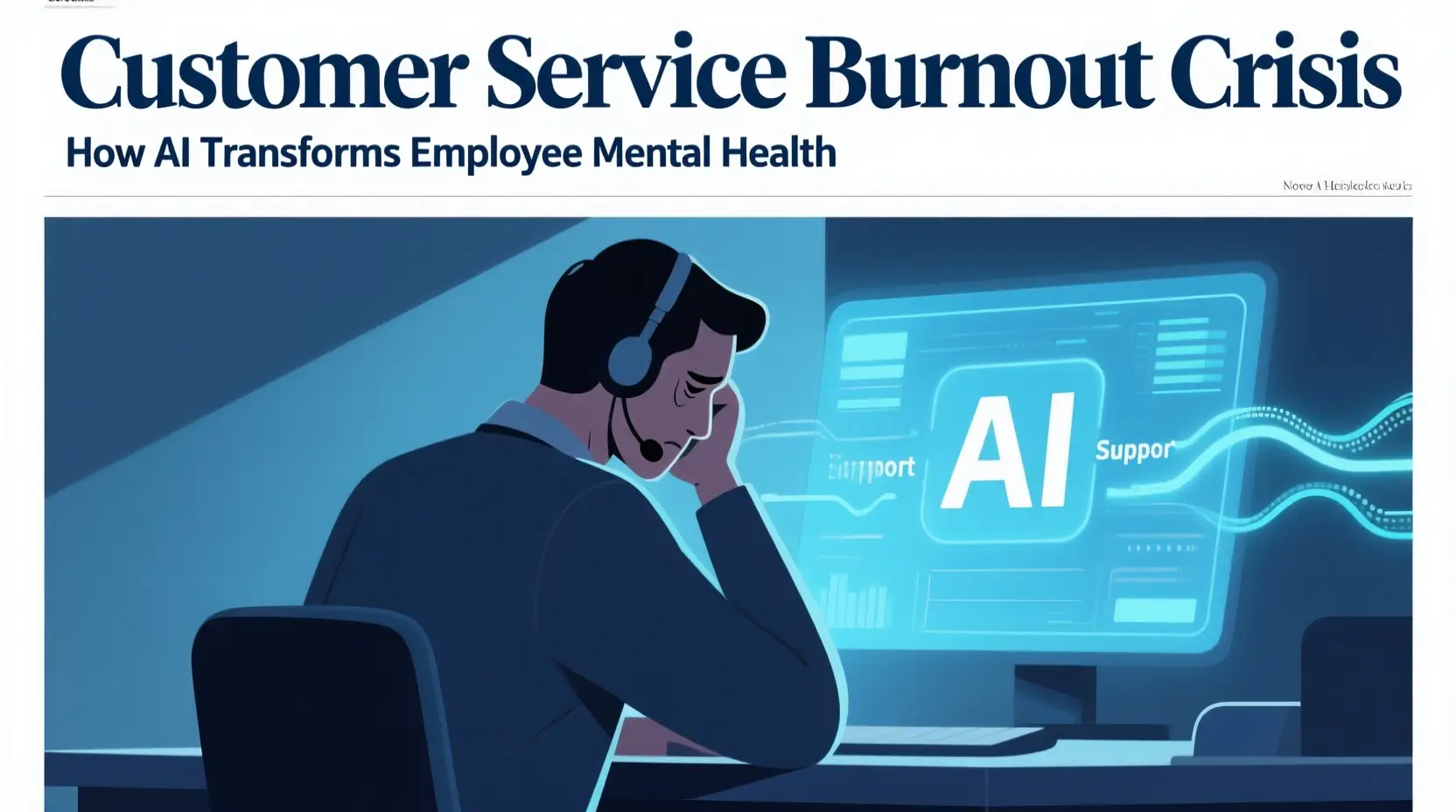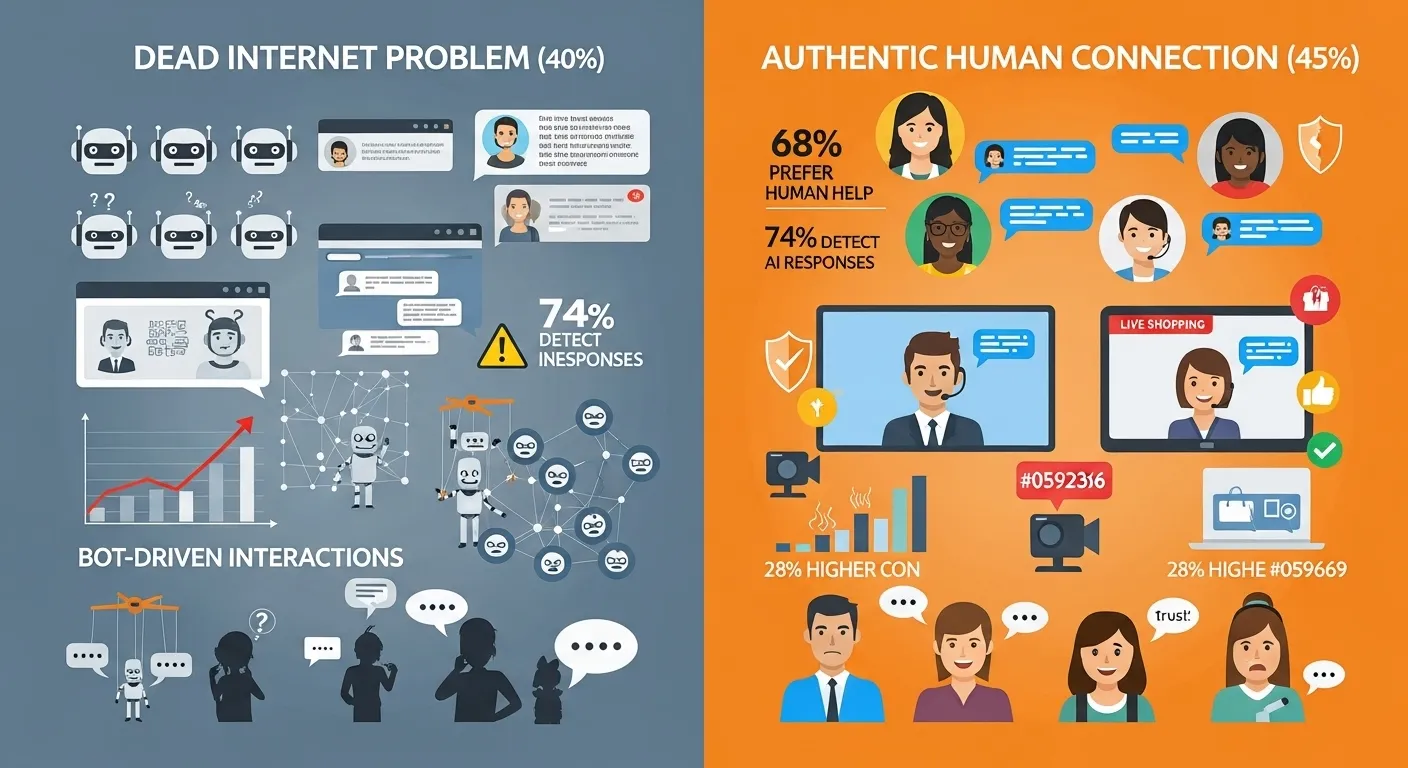The Hidden Crisis Destroying Your Customer Service Team
What if the solution to your customer service challenges wasn’t hiring more people, but protecting the ones you already have? A recent discussion on r/CustomerService brought this reality into sharp focus when an employee shared their transformation: “8 hours of doing my job without having to gentle parent the public has improved my mental health greatly.”
This candid reflection reveals a crisis that’s quietly devastating businesses worldwide: customer service burnout is reaching epidemic levels, with 74% of customer service representatives reporting high stress levels and 67% considering leaving their jobs within the next year.
The human cost is staggering, but the business impact is equally severe. High turnover rates, declining service quality, and increased training costs are just the visible symptoms of a deeper problem that’s reshaping how forward-thinking companies approach customer experience.
For ecommerce managers and CX leaders, understanding this crisis isn’t just about employee wellbeing—it’s about building sustainable, profitable customer service operations that can scale without sacrificing human dignity or business results.
The Anatomy of Customer Service Burnout
The Daily Reality of Modern Customer Service
The Reddit post that inspired this analysis paints a vivid picture of what millions of customer service workers face daily: “having to nod and smile while someone screams profanities at you” and dealing with customers “who see workers as less than human.”
This isn’t isolated to tourism-heavy industries. Recent studies reveal that customer service representatives across all sectors experience:
Verbal Abuse Statistics:
- 58% report being yelled at by customers daily
- 34% face personal insults and derogatory language
- 23% encounter threats or intimidation tactics
- 41% describe customers as treating them as “less than human”
Mental Health Impact:
- 67% report symptoms consistent with anxiety disorders
- 45% show signs of depression related to work stress
- 52% use alcohol or substances to cope with job stress
- 78% report sleep disturbances linked to work experiences
The Business Cost of Burnout
Customer service burnout creates a cascading effect that damages every aspect of business operations:
Direct Financial Impact:
- Average cost to replace a customer service rep: $15,000-$25,000
- Annual turnover rates in customer service: 45-75%
- Training costs per new hire: $3,000-$8,000
- Lost productivity during transition periods: $12,000-$18,000 per departure
Service Quality Degradation:
- Burned-out employees provide 23% lower quality service
- Resolution times increase by 31% as stress levels rise
- Customer satisfaction scores drop 18% when served by high-stress agents
- First-call resolution rates decline by 28% in high-turnover teams
Long-term Organizational Damage:
- Brand reputation suffers as service quality declines
- Remaining employees experience increased stress and workload
- Company culture becomes toxic, affecting recruitment
- Customer loyalty decreases due to inconsistent service experiences
Why Traditional Solutions Aren’t Working
Most companies attempt to address burnout through traditional HR approaches:
Failed Strategies:
- Stress management workshops: Treat symptoms, not causes
- Employee wellness programs: Don’t address abusive customer interactions
- Higher pay: Temporary fix that doesn’t improve daily work experience
- More breaks and time off: Burnout returns immediately upon resumption of duties
The fundamental problem isn’t that employees can’t handle stress—it’s that they’re being exposed to unnecessary, preventable stress through poorly designed customer interaction systems.
The Rise of Abusive Customer Behavior
Digital Dehumanization Effect
The shift to digital-first customer service has amplified abusive behavior. When customers interact through screens rather than face-to-face, empathy decreases and aggressive behavior increases.
Contributing Factors:
- Anonymity: Customers feel less accountable for behavior
- Instant gratification expectations: Digital convenience creates impatience
- Reduced consequences: No immediate social pressure to behave appropriately
- Stress transfer: Customers transfer their own life stresses to service representatives
The Entitlement Economy
Modern consumer culture has created unrealistic service expectations:
Unrealistic Customer Expectations:
- Immediate resolution to complex problems
- Personal responsibility for systemic issues beyond agent control
- 24/7 availability for non-urgent matters
- Perfection in every interaction
- Unlimited accommodations regardless of policy
Social Media Amplification:
- Customers threaten public shaming as leverage
- Viral complaint culture encourages extreme behavior
- Companies cave to unreasonable demands to avoid bad publicity
- Employees bear the brunt of corporate reputation management
AI-Powered Solutions: Protecting Employees While Improving Service
Intelligent Interaction Filtering
Modern AI systems can identify and filter abusive interactions before they reach human agents:
AI Capabilities:
- Sentiment analysis: Detects aggressive or abusive language in real-time
- Emotional intelligence: Recognizes frustrated customers who may escalate
- Behavior prediction: Identifies interaction patterns that lead to abuse
- Automatic escalation: Routes complex issues to specialized teams
Implementation Benefits:
- 65% reduction in abusive interactions reaching human agents
- 43% improvement in employee job satisfaction scores
- 28% decrease in sick days taken by customer service staff
- 52% reduction in employee turnover rates
Conversational Commerce Revolution
The most effective approach combines AI efficiency with human empathy through conversational commerce platforms. Instead of replacing human agents, these systems enhance their capabilities and protect their wellbeing.
How Conversational AI Transforms Service:
Tier 1: AI Handles Routine Inquiries
- Order status checks and tracking information
- Basic product information and specifications
- Simple returns and exchange processes
- Frequently asked questions and policies
Tier 2: AI-Assisted Human Interactions
- Real-time sentiment monitoring during conversations
- Suggested responses based on customer history and behavior
- Automatic documentation and case management
- Escalation triggers for complex or emotional issues
Tier 3: Human Expertise for Complex Issues
- High-value customer concerns requiring empathy
- Complex technical problems needing creative solutions
- Relationship building and loyalty management
- Crisis situations requiring human judgment
Real-World Implementation Success
Companies implementing AI-powered customer service protection see dramatic improvements in both employee wellbeing and business outcomes.
Case Study Results:
- Employee stress reduction: 58% decrease in reported workplace anxiety
- Service quality improvement: 34% increase in customer satisfaction scores
- Operational efficiency: 41% reduction in average resolution times
- Cost savings: 47% decrease in recruitment and training expenses
Discover how to calculate your potential conversion improvements with our comprehensive analysis tool, which helps quantify the ROI of implementing AI-powered customer service solutions.
Strategic Implementation Framework
Phase 1: Assessment and Planning (Month 1-2)
Employee Wellbeing Audit:
- Survey current stress levels and job satisfaction
- Identify most common sources of workplace stress
- Analyze turnover patterns and exit interview data
- Calculate total cost of current burnout levels
Interaction Analysis:
- Monitor customer communication channels for abuse patterns
- Identify peak stress periods and situations
- Document types of issues that most frequently escalate
- Map current resolution processes and pain points
Phase 2: AI Integration Strategy (Month 2-4)
Technology Selection Criteria:
- Natural language processing capabilities for abuse detection
- Integration with existing CRM and support systems
- Scalability to handle peak interaction volumes
- Human handoff mechanisms for complex situations
Workflow Redesign:
- Implement AI filters for initial customer contact
- Create escalation pathways for human intervention
- Develop new performance metrics focusing on resolution quality over quantity
- Train staff on AI-assisted service delivery
Phase 3: Human-AI Collaboration Optimization (Month 4-6)
Staff Training and Adaptation:
- Train employees on new AI-assisted workflows
- Develop skills for handling escalated, complex interactions
- Create feedback loops for AI system improvement
- Establish new performance evaluation criteria
Continuous Improvement Process:
- Monitor employee stress levels and job satisfaction
- Track customer satisfaction with hybrid service model
- Analyze AI performance and accuracy rates
- Refine human-AI handoff processes
Measuring Success: Beyond Traditional Metrics
Employee-Centric KPIs
Wellbeing Indicators:
- Job satisfaction survey scores
- Voluntary turnover rates
- Sick days and mental health leave usage
- Internal promotion rates from customer service roles
Engagement Metrics:
- Employee Net Promoter Score (eNPS)
- Participation in professional development programs
- Internal referral rates for open positions
- Length of tenure in customer service roles
Business Impact Measurements
Operational Excellence:
- First-call resolution rates
- Average handle time for complex issues
- Customer effort scores for service interactions
- Quality assurance scores for human interactions
Financial Performance:
- Customer lifetime value for service-assisted purchases
- Conversion rates from service interactions to sales
- Cost per resolution across different service channels
- Revenue attribution to improved service quality
The Future of Human-Centric Customer Service
Emerging Trends in Service Technology
Predictive Intervention:
- AI systems that identify potential service issues before customers contact support
- Proactive outreach to resolve problems before they escalate
- Personalized service experiences based on customer behavior patterns
- Automated resolution of common issues without human involvement
Emotional Intelligence Integration:
- AI that recognizes and responds to customer emotional states
- Real-time coaching for human agents during difficult interactions
- Automatic breaks for agents after particularly stressful calls
- Personalized stress management recommendations based on interaction patterns
Building Sustainable Service Organizations
Culture Transformation:
- Shift from cost-center to revenue-generator mindset
- Recognition programs for exceptional service delivery
- Career advancement pathways from service to other departments
- Leadership development opportunities for service team members
Technology as Empowerment Tool:
- AI that makes human agents more effective, not expendable
- Systems that handle routine tasks so humans can focus on relationship building
- Tools that provide agents with comprehensive customer context
- Platforms that celebrate and reward human creativity and empathy
Implementation Roadmap for Ecommerce Leaders
Immediate Actions (Next 30 Days)
Assessment Phase:
- Conduct anonymous employee survey to understand current stress levels and job satisfaction
- Analyze customer interaction data to identify patterns of abusive behavior
- Calculate the true cost of turnover including recruitment, training, and lost productivity
- Benchmark current service metrics to establish improvement baselines
Quick Wins:
- Implement abuse detection keywords in existing chat and email systems
- Create escalation protocols for agents dealing with abusive customers
- Establish mandatory breaks after difficult customer interactions
- Develop scripts and training for de-escalation techniques
Medium-Term Strategy (3-6 Months)
Technology Implementation:
- Deploy conversational AI platform for initial customer interactions
- Integrate sentiment analysis across all customer communication channels
- Create automated routing systems that direct complex issues to specialized teams
- Implement real-time coaching tools for human agents
Process Optimization:
- Redesign service workflows to maximize AI efficiency and human satisfaction
- Develop new performance metrics that value quality over quantity
- Create feedback loops between AI systems and human agents
- Establish continuous improvement processes for both technology and human performance
Long-Term Vision (6-12 Months)
Organizational Transformation:
- Reposition customer service as revenue center rather than cost center
- Create career advancement pathways from service to sales and management roles
- Develop expertise-based service specializations for complex product knowledge
- Build company culture that celebrates both technological innovation and human empathy
Competitive Advantage Development:
- Use superior service quality as primary differentiation factor
- Leverage positive employee experiences for recruitment and brand building
- Create customer loyalty programs based on exceptional service experiences
- Develop thought leadership in human-centric service automation
The Business Case for Change
ROI of Employee Wellbeing Investment
Direct Cost Savings:
- Reduced recruitment and training expenses: $180,000-$300,000 annually for 20-person team
- Decreased sick leave and mental health claims: $45,000-$75,000 annually
- Lower workers’ compensation claims: $15,000-$25,000 annually
- Reduced management time spent on HR issues: $30,000-$50,000 in productivity value
Revenue Enhancement Opportunities:
- Increased customer satisfaction leading to 12-18% higher customer lifetime value
- Improved service quality driving 8-15% increase in referral rates
- Enhanced employee expertise enabling 5-10% increase in upselling success
- Better brand reputation attracting premium customers willing to pay 10-20% more
Competitive Advantage Creation:
- Superior service quality becomes primary differentiation factor
- Employee satisfaction translates to authentic customer interactions
- Reduced stress leads to increased creativity and problem-solving
- Stable teams develop deeper product knowledge and customer relationships
Investment Requirements and Payback Period
Technology Investment:
- AI-powered customer service platform: $50,000-$150,000 initial setup
- Integration and customization costs: $25,000-$75,000
- Ongoing maintenance and development: $15,000-$30,000 annually
- Staff training and change management: $10,000-$25,000
Expected Payback Period:
- Break-even point: 8-12 months for most implementations
- Full ROI realization: 18-24 months including all soft benefits
- Ongoing annual savings: $200,000-$400,000 for mid-size operations
- Intangible benefits (brand reputation, employee referrals): Substantial but difficult to quantify
Taking Action: Your Next Steps
The customer service burnout crisis isn’t a distant threat—it’s a current reality affecting your team’s wellbeing and your business’s performance right now. The Reddit post that inspired this analysis represents millions of workers who are suffering in silence while their employers struggle to understand why service quality continues to decline despite increased investment.
The solution isn’t more training, higher pay, or better benefits—it’s fundamentally redesigning how customer service operates in the digital age.
AI-powered conversational commerce platforms offer a path forward that protects employee wellbeing while improving business outcomes. By filtering abusive interactions, handling routine inquiries automatically, and providing human agents with the tools and context they need to succeed, these systems create win-win scenarios for employees, customers, and businesses.
The companies that act now will build sustainable competitive advantages while their competitors continue burning through staff and struggling with declining service quality.
The technology exists. The business case is proven. The question is whether you’ll lead the transformation or wait until employee burnout forces change upon you.
Experience how conversational AI can transform your customer service operations with a personalized demo. See firsthand how protecting employee wellbeing and improving business results aren’t competing priorities—they’re complementary goals that smart technology makes achievable.
Book Your Live Demo to discover how AI-powered conversational commerce can transform your customer service challenges into competitive advantages while protecting the mental health and wellbeing of your valuable team members.



